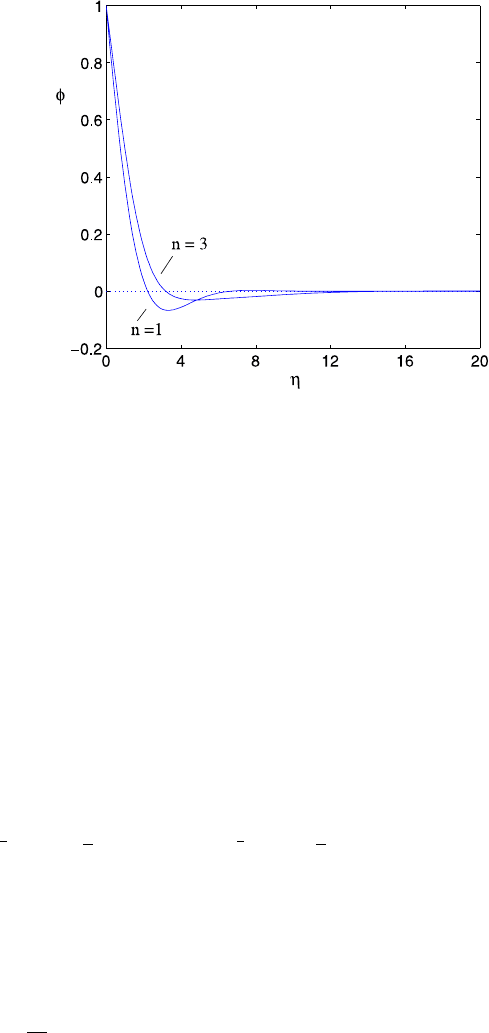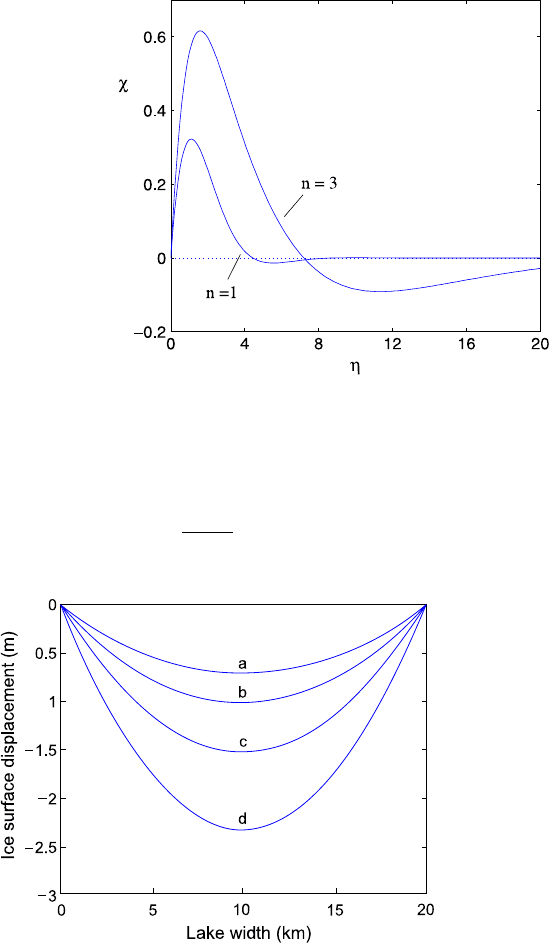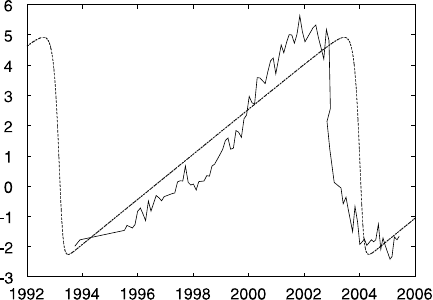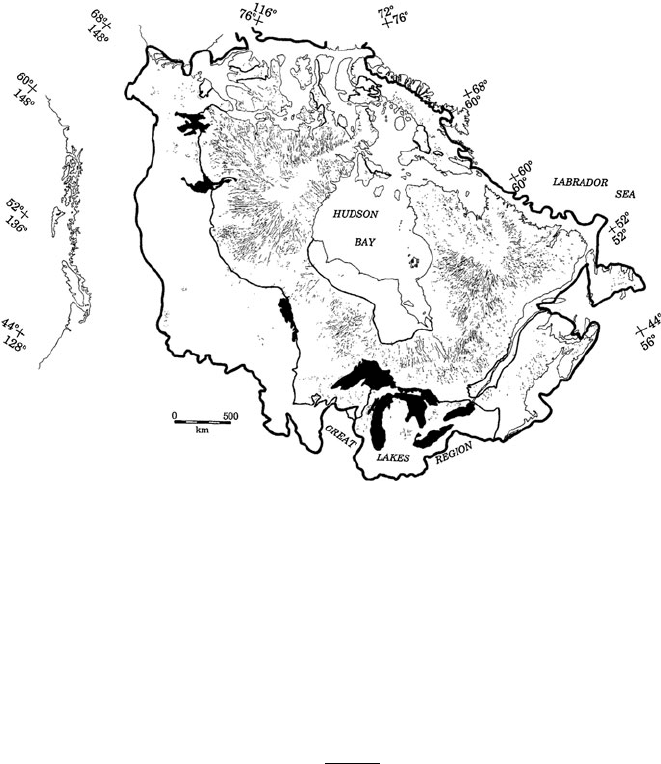Fowler A. Mathematical Geoscience
Подождите немного. Документ загружается.


770 11 Jökulhlaups
and Υ and N satisfy the boundary layer equations
Υ
XX
|Υ
XX
|
(n−1)/n
XX
=−N,
N
t
=Υ,
(11.134)
with boundary conditions
N =N
+
,Υ=
˙
N
+
,Υ
XX
=0onX =0,
Υ →0asX →∞.
(11.135)
Suppose now that
N
+
=
c
(
¯
t −t)
α
,t<
¯
t. (11.136)
We seek a similarity solution in the form
N =N
+
ψ(η), Υ =
˙
N
+
φ(η), η =
mX
(
¯
t −t)
b
; (11.137)
substituting these forms into the boundary layer equations, we find that we require
b =
(n −1)α −1
2(n +1)
, (11.138)
and then φ and ψ satisfy the boundary value problem
φ
|φ
|
(n−1)/n
=−Γψ,
εηψ
+ψ =φ,
(11.139)
where
ε =
(n −1)α −1
2(n +1)α
,Γ=
c
n−1
αm
2(n+1)
1/n
; (11.140)
Γ can be chosen arbitrarily through the choice of m. To be precise, we choose
Γ =1, so that
m
2(n+1)
=
c
n−1
α
; (11.141)
it follows from this that
η =
N
n
+
˙
N
+
1
2(n+1)
X. (11.142)
The boundary conditions for φ and ψ are
φ =1,ψ=1,φ
=0onη =0,
φ →0asη →∞.
(11.143)
To solve these equations, it is convenient to define the subsidiary function χ via
χ =
φ
|φ
|
(n−1)/n
, (11.144)

11.6 Cauldrons and Calderas 771
Fig. 11.10 Solution of
(11.146)and(11.147)forφ,
with n =1(asin(11.148))
and n =3
so that
φ
=χ |χ|
n−1
,χ
=−φ. (11.145)
We note that if n =3 and α =3, the parameter ε ≈0.2 and is small. This suggests a
perturbation solution for the equations. Although apparently a singular perturbation,
we see from the boundary conditions that the perturbation is actually regular; the
neglect of the term in ε suppresses a singular solution ψ ∝η
−1/ε
which is precluded
by the boundary condition for ψ. At leading order ψ = φ, and the problem thus
reduces to
φ
=χ |χ|
n−1
,
χ
=−φ,
(11.146)
with
φ =1,χ=0onη =0,
φ →0,χ→0asη →∞.
(11.147)
When n =1, the problem can be solved analytically, and we obtain
φ =e
−η/
√
2
cos
η/
√
2
,χ=e
−η/
√
2
sin
η/
√
2
(11.148)
(see also Question 11.10). For n>1, a numerical solution is necessary. Figures
11.10 and 11.11 show the solution of (11.146) with (11.147)forn =1, as well as a
numerical solution for n =3.
To find the subsidence profile, we solve (11.98), using the definition of w in
(11.132) and (11.137), thus
∂s
∂t
=−μ
˙
N
+
1 −φ(η)
. (11.149)
Figure 11.12 shows a simulation of this model.

772 11 Jökulhlaups
Fig. 11.11 Solution of
(11.146)and(11.147)forχ ,
with n =1(asin(11.148))
and n =3. When n =3, the
maximum value of χ = 0.615
at η =1.6
It is of interest to calculate the maximum stress and bending moment in the beam.
From (11.85) and (11.125), the maximum stress is at the surface and base of the ice,
and is given by
|τ
1
|
max
=
Hw
xx
A
1/n
. (11.150)
Fig. 11.12 Solution of (11.149) (starting at t = 0 days) at times (a) t = 350 days, (b) t = 371
days, (c) t =382 days, (d) t = 393 days using (11.136)forN
+
,with
¯
t = 1, c = 2.5 ×10
−3
, α = 3,
γβ/ν
2
=15.8. The dimensional blow-up time is 416 days, and the units of vertical subsidence are
metres, corresponding to a choice of μd =N
0
/ρ
i
g = 3 m, and thus N
0
=0.27 bars. The results are
plotted as if for a lake of width 20 km, in which case if d =4km,thenν =0.2 and thus γβ =0.63,
corresponding to a value of τ
A
=0.43 bars

11.7 Floods from Ice Sheets 773
After some algebra, we find that the maximum stress is
|τ
1
|
max
=
H
A
1/n
γβ
ν
2
D
n
N
+
˙
N
+
1/(n+1)
|χ|, (11.151)
and the bending stress M in (11.133) is given by
M =
γβ
ν
2
D
n
n
N
+
˙
N
+
1/(n+1)
χ. (11.152)
When n = 1, the maximum stress and bending stress are at η = 1.11, where χ =
0.32. For n =3, the maximum dimensionless bending stress is χ =0.62 at η =1.6.
Ring Fractures
Since (via (11.66), (11.76) and (11.77)) the longitudinal stress is scaled with τ
A
,we
see from (11.151) that when n = 3, the maximum stress in the overlake ice has a
dimensional value of
τ
max
≈0.76
γβ
ν
2
N
+
˙
N
+
1/4
τ
A
, (11.153)
where we take H =A = 1 and use the definition of D
n
in (11.127) and the maxi-
mum of χ ≈0.62; the maximum occurs at a distance from the margin of
x =1.6
˙
N
+
N
3
+
1/8
ν
1/2
l
w
(γβ)
1/4
, (11.154)
where l
w
is the lake width. If τ
max
reaches the yield stress τ
c
of ice, then the ice will
fracture, forming a crevasse, and the overlake ice will reset itself to the application
of effective boundary conditions at the position of this ring fracture. Thereafter,
continued rise of effective pressure will allow a new ring fracture to occur in-lake
of the old fracture, and in this way a sequence of such fractures may form, with a
spacing indicated by (11.154), as seen in Fig. 11.9. If we equate τ
max
=τ
c
, and use
(11.153) to eliminate
˙
N
+
, we find that the fracture spacing should be
x ≈1.84
τ
c
τ
A
1/2
ν
2
γβ
3/8
l
w
N
1/2
+
. (11.155)
Estimates of this are typically less than the lake width, but do not appear con-
sistent with the small scale (tens of metres) cracks visible in Fig. 11.9,forwhich
some further development of the theory would appear to be necessary, for example
associated with the finite strain of the surface ice.
11.7 Floods from Ice Sheets
We have mostly focussed our attention on subglacial floods from beneath glaciers or
small ice caps. There is no intrinsic reason why floods should not occur from lakes
774 11 Jökulhlaups
beneath ice sheets. It is now known that there are many lakes beneath the Antarctic
ice sheet, for example, and it seems reasonable to suppose that these might also
drain semi-periodically. There is in fact now a good deal of evidence for this, and
there is plenty of evidence of floods from ice sheets during the last ice ages. We now
gather together some of this story.
Badlands According to Webster’s dictionary, badlands are regions marked by
intricate erosional sculpturing, scanty vegetation, and fantastically formed hills. In
eastern Washington State in the U.S.A., the Channelled Scablands are an example
of such a landscape. They were formed as a result of massive floods from glacial
Lake Missoula, a pro-glacial lake which formed south of the Cordilleran Ice Sheet
(the western part of the Laurentide Ice Sheet). It is thought that the drainage of
Missoula was blocked by a lobe of the ice sheet, and that the resulting massive build-
up of the lake to a volume in excess of 2,000 cubic kilometres, led to a sequence
of floods (at least 40, probably more, at intervals of years to decades) of enormous
magnitude (estimates for peak discharge are in the region of 10
7
m
3
s
−1
); these
floods caused the massive erosion which formed the scablands. Flow speeds of the
order of 25 m s
−1
and flow depths of up to 300 m caused the erosion of channels
into the solid basaltic rock, and the formation of gigantic forms of lateral bars and
ripples.
The 8,200 Year B.P. Cooling Event We have already discussed the sudden cli-
matic cooling event at 8,200 years B.P. (before present, the ‘present’ being taken
as 1950). It is thought that this is due to the catastrophic flooding of glacial Lake
Agassiz, which formed south of the dwindling Laurentide ice sheet, in the vicinity
of Hudson Bay, as the ice melted. The meltwater builds up behind the ice, but is
blocked from escaping to the south. Eventually, a flood is initiated, probably un-
der the ice sheet, causing massive influx of fresh water to the Hudson Strait, and
thence to the North Atlantic, where, as discussed in Chap. 2, it can temporarily shut
down the oceanic thermohaline circulation, and thus cause a sudden cooling in the
northern hemisphere.
Floods from the Antarctic Similar scabland landscapes have been reported on
high terrain in Antarctica, which indicate that massive floods occurred there also. It
is thought that these floods are subglacial (because they are at such high elevation),
and this suggests that massive sub-Antarctic jökulhlaups have occurred in the past.
The likely candidate for the source of such a massive flood is Lake Vostok, con-
taining some 5,400 cubic kilometres of water, and situated under the central part of
East Antarctica. There is in fact little to distinguish sub-ice sheet floods mathemat-
ically from sub-ice cap floods, beyond the different scales. If there is net drainage
towards the lake, and this is not taken up by basal freeze-on to the base of the ice,
then inevitably, it seems, a flood will occur. Modelling of the filling of Lake Vostok,
for example, suggests that floods with peak discharges of the order of 10
5
m
3
s
−1
lasting for a year can occur, with a period of the order of 40,000 years.
Much smaller floods are known to occur (from other lakes) at present, and ap-
pear to constitute the natural way in which drainage takes place beneath the ice

11.7 Floods from Ice Sheets 775
sheet. Satellite imagery has revealed relatively rapid ice surface collapses (of order
of metres in a year), which are presumably due to one subglacial lake discharging
into another. We can imagine drainage under the ice sheet as consisting of a pseudo-
porous flow effected by short term drainage events between the lakes, which act as
the pores of the medium.
A question which arises is whether the Nye–Röthlisberger theory can predict
these small amplitude fluctuations. Returning to the theory, we see that (11.27)im-
plies that, since the total discharge ∼Q
0
t
0
is of the order of A
L
h
d
, where h
d
is the
drawdown depth, we have
h
d
∼
N
0
ρ
w
g
. (11.156)
This suggests that if the drawdown is, as frequently observed, of the order of a metre,
then N
0
∼ρ
w
gh
d
∼0.1 m. A drawdown of 4 metres is consistent with N
0
∼0.4m,
similar to values inferred on the Whillans ice stream B.
In turn, our discussion of drainage mechanics in Chap. 10 suggests that such low
effective pressures are consistent with a canal-type drainage over sediments. Two
questions now arise: first, can our previous theory reproduce such differently scaled
floods, and second, is such a theory consistent with canal-style drainage?
To answer the first, we consider the dependence of the effective pressure scale
N
0
on the volume flux scale Q
0
.From(11.16), we can deduce
N
0
=
Φ
11/8
0
ρ
i
KL(fρ
w
g)
3/8
1/n
Q
1/4n
0
(11.157)
(cf. (10.226)). If a 20 km by 20 km lake deflates by 4 m in a year, we can estimate
the volume flux as 50 m
3
s
−1
. Even if this is two orders of magnitude less than the
floods found in Fig. 11.6, it changes N
0
by less than a factor of two. Although there
are many parameters in (11.157), few of them are adjustable. The simplest way to
reduce N
0
in (11.157) from 32 bars (see (11.20)) to < 1 bar is to increase the closure
coefficient K by (say) four orders of magnitude. In terms of viscosity, this means
replacing an ice viscosity of 2 ×10
13
Pa s by one of 2 ×10
9
Pa s, coincidentally
similar to early estimates of till ‘viscosity’. Recalling that Q
0
is calculated inde-
pendently via (11.28), we see that increasing K by 10
4
does indeed reduce Q
0
by
10
2
, and thus reduces N
0
by 10
3/2
≈ 31.6toavalue≈ 1 bar. The time scale also
becomes a little longer, although not apparently as much as one would like. Never-
theless, if one simply takes the Grímsvötn model and increases K by 10
4
, together
with a suitable refilling rate to give a period of ten years, we obtain the fit shown in
Fig. 11.13 to data measured on the Lambert Glacier in Antarctica, where there is an
apparent flood every ten years or so.
Thus it seems we can replicate these short term, small amplitude floods; but there
are issues in the data in Fig. 11.13 which give cause for concern. The recovery phase
shows that surface elevation accelerates as it rises, completely at odds with the Nye
theory. And, while the abrupt phase of the flood is well represented by the model,
the slow down of the subsidence towards the end is also problematic.
In fact, one should have misgivings about applying the Nye theory as it stands.
Apparently, (11.157) indicates the usual Röthlisberger balance which presumably

776 11 Jökulhlaups
Fig. 11.13 The Nye theory for surface elevation (in metres) (computed from the effective pressure
variation), assuming geometric parameters appropriate to the Lambert Glacier. The solid line in-
dicates surface elevation, from ERS satellite altimeter data provided by Andy Shepherd, while the
dashed line comes from the solution of the Nye model. The principal changes in the parameters
are that we take K =0.5 ×10
−20
Pa
−3
s
−1
, which enables the relatively small amplitude change,
and the lake refilling rate is taken to be 7 m
3
s
−1
, in order to obtain a period of ten years
is inappropriate for drainage through sediments, where the equilibrium of (11.17)
1
ought to correspond to N being a decreasing function of Q. What is needed is a
theory of floods through sediment-floored canals, but that has yet to be constructed.
Dansgaard–Oeschger Events Dansgaard–Oeschger events were described in
Sect. 2.5.5. They are rapid changes of northern hemisphere climate (by five to
ten degrees Celsius) which occurred on a time scale of decades during the last ice
age, and which occur semi-periodically, with a rough period of some 1,500 years.
In Sect. 2.5.5, we raised the idea that sub-Laurentide jökulhlaups might provide a
mechanism for the freshwater release, but postponed a detailed discussion. We pro-
vide some further discussion now.
The main problem with sub-Laurentide lake floods is the problem of where
do you store the water. Since we know that there were massive pro-glacial lakes
(Glacial Lake Agassiz, Glacial Lake Missoula, for example), we can certainly con-
template the existence of massive sub-ice sheet lakes. But why would they form?
Lake Vostok in Antarctica lies in a deep tectonic basin, but such tectonic features
are largely absent under the Laurentide Ice Sheet.
A clue may lie in the contemplation of Fig. 11.14, which shows the association
of eskers with the area of exposed bedrock (shield), suggesting that drainage beyond
this region might have taken the form of a distributed, canal-like system at a lower
effective pressure. If that were the case, then the subglacial streams making their
way from the central ice domes would encounter a transition at the edge of the
bedrock where they would face a virtual escarpment. The hydraulic head (cf. (11.8))
of the subglacial water is
φ =−N +ρ
i
gs +ρ
wi
gb, (11.158)

11.7 Floods from Ice Sheets 777
Fig. 11.14 The Laurentide Ice Sheet during the last glaciation (heavy line). The inner solid curve
marks the boundary of the mostly exposed crystalline bedrock. Note the gap to the upper right
of the Great Lakes, where the St. Lawrence ice stream flowed into the Gulf of St. Lawrence. The
short fine lines, mostly within the bedrock region, represent eskers. The black regions represent
major lakes, ranging westwards from the Great Lakes through Lake Winnipeg, Great Slave Lake,
and Great Bear Lake. Figure copyright Geological Society of America, reproduced from Clark and
Walder (1994), Fig. 5, and kindly provided by Peter Clark
so, presuming the ice surface s is continuous, a jump down in effective pressure of
N corresponds to a jump up in bed elevation b of
b =
N
ρ
wi
g
. (11.159)
If the effective pressure were 10 bars on the bedrock side and 1 bar on the
sediment side, then in effect the streams would encounter a barrier of elevation
≈1100 m. This is a fairly significant barrier, requiring an ice surface drop of 100 m
to overcome it. If the transition takes place over 100 km, then the ice surface slope
can probably compensate, but if it occurs more rapidly, then water may accumulate
at the base of the virtual scarp, causing a subglacial lake to form. This is a runaway
process, because the formation of the lake drops the basal shear stress to zero, thus
tending to flatten the ice surface and removing its slope.
This raises the possibility that the present lakes surrounding the Canadian Shield
are the remnant of former subglacial lakes. The lakes might have been strung to-
gether like a necklace, allowing for circumferential drainage between them, ending
with discharge down the St. Lawrence spillway.

778 11 Jökulhlaups
There are a number of effects of such putative lakes on the ice dynamics. The
ice above a lake becomes an ice shelf, controlled by longitudinal stresses. There is
a grounding line at each margin, and the upstream grounding line, at least, has an
enhancement of shear stresses (see (10.133), (10.147) and (10.148)) by a factor of
(
δ
ε
)
2/(n+2)
≈ 6.3. This suggests that the ice will dig itself a hole upstream of the
lake, providing for the continued existence of the lake after the ice sheet has gone. It
seems possible that the Great Lakes, indeed all of these shield-marginal lakes, could
have been constructed in this way.
The dynamics at the downstream grounding line are less clear, partly because the
effective pressure is low. Indeed, the transition to low N heralds the condition for
ice stream dynamics, and it may thus be no coincidence that several subglacial lakes
in Antarctica have been found at the heads of ice streams. The presence of a lake
promotes faster flow, and this may well provide the necessary seeding for ice stream
formation downstream.
Floods on Mars As we discussed in Chap. 10, there is ice on Mars, both in the
polar ice caps, and in the soil. Many geomorphological features show evidence of
the past presence of liquid water or ice on the surface, and in particular, there are
many indications of massive outflow channels. These features have led people to
suppose that at one time water was plentiful on the surface, perhaps forming an
ocean in the northern lowlands,
6
and that there may have been large ice caps, from
beneath which powerful jökulhlaups emerged to carve the Martian surface features.
7
The question arises, how could this come about? One attractive idea views the
hydrological cycle on Mars in the following way. Just as on Earth, planetary out-
gassing from volcanoes produces water vapour and carbon dioxide. And just as on
Earth, volcanoes erupt periodically. The larger the volcano, the larger the eruption
and the longer the period between eruptions. The largest eruptions on Earth (the
basaltic flood eruptions, described in Sect. 9.1) are thought to be associated with
the arrival at the crust of giant thermal plumes in the Earth’s mantle (see Chap. 8),
associated with time-periodicity of mantle convection. On Mars, which hosts the
largest volcano in the Solar System, Olympus Mons, it is reasonable to suppose that
extremely massive eruptions may occur at intervals of perhaps tens of millions of
years. The resulting greenhouse-induced heating of permafrost causes massive out-
flows and the collapse of the source terrain: essentially a hydraulic volcano. These
floods flow into the northern lowlands, forming an ocean, whose evaporation and
subsequent precipitation forms large ice sheets in the southern highlands, whence
form the glacially sculpted features which are observed. The outgassing produces
enough greenhouse gas to warm the atmosphere (allowing water to form), and also
increases atmospheric pressure above the triple point pressure so that water is sta-
ble. As the volcanic activity subsides, the atmosphere cools, and the climate reverts
to its present cold, dry interglacial type. As with much else concerning Mars and
6
The hypsometry of Mars is odd: the southern hemisphere is elevated, and the northern hemisphere
is relatively flat, and much lower.
7
The study of Martian landforms is called areomorphology.

11.8 Notes and References 779
the other planets, data are scarce, hypotheses are cheap, and speculation is rife. But
then, it is the imaginative aspect of science that makes it so much fun.
11.8 Notes and References
Much of the early literature on Icelandic jökulhlaups is in Icelandic (!), for example
in the journal Jökull; a more accessible introduction to the subject are the papers
by Björnsson (1974, 1992), and in particular the same author’s book (Björnsson
1988) gives a thorough review, and is an essential classic. The theoretical literature
is somewhat sparse, but shows signs of maturation with the increasing interest in
palaeo-floods on Earth and Mars. The seminal paper is by Nye (1976), who pre-
sented the basic theory. Variants on the model are discussed by Spring and Hutter
(1981) and Clarke (1982); in particular, they emphasise the importance of the tem-
perature equation. Clarke (2003) critically reviews flood modelling, and in particu-
lar discusses and recalibrates the flow resistance of the channel. There is also a brief
discussion in the book by Paterson (1994).
The recent 1996 eruption and its aftermath was described at the time on a number
of web pages; for example see http://www.spri.cam.ac.uk/jok/jok.htm. A descrip-
tion is given in the paper by Gudmundsson et al. (1997). A recent review which
gives a very complete historical account of the subject, and which also emphasises
the differences between the Nye-type melt-opening jökulhlaup and the Gjálp-type
hydrofracturing jökulhlaup, is that by Roberts (2005).
Nye’s Model Nye’s (1976) model is a fairly astonishing tour de force. In partic-
ular, his derivation of the energy equation (11.4) is succinct and to the point. It is,
however, a physicist’s derivation (there is work done here and here, energy gained
there, etc.), and it is not something that in the nature of things satisfies a mathe-
matician, who wants to see a formal derivation. Spring and Hutter (1982) provided
such a derivation, and this exercise is repeated in Appendix E, which attempts to
draw a middle line between Nye’s direct approach, and the very abstract approach
of Spring and Hutter. Although Eq. (11.4) appears ‘obvious’, this appendix suggests
that it is far from being so.
Wide Channels and Other Problems Despite its quite astonishing success, the
Nye model (and our solution of it) has a number of difficulties associated with it. The
first of these is the assumption of a semi-circular channel. With an assumption of
easy lateral slip of ice at the bed, the resulting closure can be calculated from that for
a circular channel. But why should the channel be semi-circular? This assumption
seems completely arbitrary, yet the resulting theory appears to work exceptionally
well.
8
Particularly when one considers the peak size of S (≈600 m
2
for Fig. 11.6,
8
At least during floods. In normal circumstances, wide channels may be preferred (Hooke et al.
1990). See also the discussion on hybrid channels in the notes for Chap. 10.
